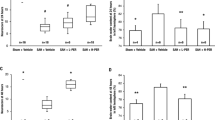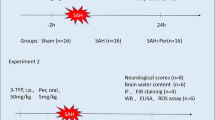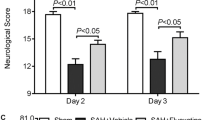Abstract
This study was aimed to investigate if acute neuronal apoptosis is induced by activation of AMPA (α-amino-3-hydroxy-5-methyl-4-isoxazole propionate) receptors (AMPARs) and inhibited by a clinically available selective AMPAR antagonist and antiepileptic drug perampanel (PER) in subarachnoid hemorrhage (SAH), and if the mechanisms include upregulation of an inflammation-related matricellular protein periostin. Sham-operated and endovascular perforation SAH mice randomly received an administration of 3 mg/kg PER or the vehicle intraperitoneally. Post-SAH neurological impairments and increased caspase-dependent neuronal apoptosis were associated with activation of AMPAR subunits GluA1 and GluA2, and upregulation of periostin and proinflammatory cytokines interleukins-1β and -6, all of which were suppressed by PER. PER also inhibited post-SAH convulsion-unrelated increases in the total spectral power on video electroencephalogram (EEG) monitoring. Intracerebroventricularly injected recombinant periostin blocked PER’s anti-apoptotic effects on neurons. An intracerebroventricular injection of a selective agonist for GluA1 and GluA2 aggravated neurological impairment, neuronal apoptosis as well as periostin upregulation, but did not increase the EEG total spectral power after SAH. A higher dosage (10 mg/kg) of PER had even more anti-apoptotic effects compared with 3 mg/kg PER. Thus, this study first showed that AMPAR activation causes post-SAH neuronal apoptosis at least partly via periostin upregulation. A clinically available AMPAR antagonist PER appears to be neuroprotective against post-SAH early brain injury through the anti-inflammatory and anti-apoptotic effects, independent of the antiepileptic action, and deserves further study.






Similar content being viewed by others
Data Availability
Data from this study are available from the corresponding author on reasonable request.
References
Suzuki H, Shiba M, Nakatsuka Y, Nakano F, Nishikawa H. Higher cerebrospinal fluid pH may contribute to the development of delayed cerebral ischemia after aneurysmal subarachnoid hemorrhage. Transl Stroke Res. 2017;8:165–73.
Suzuki H. What is early brain injury? Transl Stroke Res. 2015;6:1–3.
Suzuki H, Kanamaru H, Kawakita F, Asada R, Fujimoto M, Shiba M. Cerebrovascular pathophysiology of delayed cerebral ischemia after aneurysmal subarachnoid hemorrhage. Histol Histopathol. 2021;36:143–58.
Kim JA, Rosenthal ES, Biswal S, Zafar S, Shenoy AV, O’Connor KL, Bechek SC, Valdery Moura J, Shafi MM, Patel AB, Cash SS, Westover MB. Epileptiform abnormalities predict delayed cerebral ischemia in subarachnoid hemorrhage. Clin Neurophysiol. 2017;128:1091–9.
Suzuki H, Kawakita F, Asada R. Neuroelectric mechanisms of delayed cerebral ischemia after aneurysmal subarachnoid hemorrhage. Int J Mol Sci. 2022;23:3102.
Kawakita F, Kanamaru H, Asada R, Suzuki Y, Nampei M, Nakajima H, Oinaka H, Suzuki H. Roles of glutamate in brain injuries after subarachnoid hemorrhage. Histol Histopathol. 2022;37:1041–51.
Henshall DC, Simon RP. Epilepsy and apoptosis pathways. J Cereb Blood Flow Metab. 2005;25:1557–72.
Kett-White R, Hutchinson PJ, Al-Rawi PG, Gupta AK, Pickard JD, Kirkpatrick PJ. Adverse cerebral events detected after subarachnoid hemorrhage using brain oxygen and microdialysis probes. Neurosurgery. 2002;50:1213–22.
Zhang C, Jiang M, Wang WQ, Zhao SJ, Yin YX, Mi QJ, Yang MF, Song YQ, Sun BL, Zhang ZY. Selective mGluR1 negative allosteric modulator reduces blood-brain barrier permeability and cerebral edema after experimental subarachnoid hemorrhage. Transl Stroke Res. 2020;11:799–811.
Scharfman HE. The neurobiology of epilepsy. Curr Neurol Neurosci Rep. 2007;7:348–54.
Lv JM, Guo XM, Chen B, Lei Q, Pan YJ, Yang Q. The noncompetitive AMPAR antagonist perampanel abrogates brain endothelial cell permeability in response to ischemia: Involvement of claudin-5. Cell Mol Neurobiol. 2016;36:745–53.
Guo C, Ma YY. Calcium permeable-AMPA receptors and excitotoxicity in neurological disorders. Front Neural Circuits. 2021;15:711564.
Suzuki H, Miura Y, Yasuda R, Yago T, Mizutani H, Ichikawa T, Miyazaki T, Kitano Y, Nishikawa H, Kawakita F, Fujimoto M, Toma N. Effects of new-generation antiepileptic drug prophylaxis on delayed neurovascular events after aneurysmal subarachnoid hemorrhage. Transl Stroke Res. 2022. https://doi.org/10.1007/s12975-022-01101-9.
Kawakita F, Kanamaru H, Asada R, Imanaka-Yoshida K, Yoshida T, Suzuki H. Inhibition of AMPA (α-Amino-3-Hydroxy-5-Methyl-4-Isoxazole Propionate) receptor reduces acute blood-brain barrier disruption after subarachnoid hemorrhage in mice. Transl Stroke Res. 2022;13:326–37.
Chen T, Zhu J, Wang YH. RNF216 mediates neuronal injury following experimental subarachnoid hemorrhage through the Arc/Arg31-AMPAR pathway. FASEB J. 2020;34:15080–92.
Chen T, Liu WB, Qian X, Xie KL, Wang YH. The AMPAR antagonist perampanel protects the neurovascular unit against traumatic injury via regulating Sirt3. CNS Neurosci Ther. 2021;27:134–44.
Niu HX, Wang JZ, Wang DL, Miao JJ, Li H, Liu ZG, Yuan X, Liu W, Zhou JR. The orally active noncompetitive AMPAR antagonist perampanel attenuates focal cerebral ischemia injury in rats. Cell Mol Neurobiol. 2018;38:459–66.
Kanamaru H, Kawakita F, Nakano F, Miura Y, Shiba M, Yasuda R, Toma N, Suzuki H, pSEED group. Plasma periostin and delayed cerebral ischemia after aneurysmal subarachnoid hemorrhage. Neurotherapeutics. 2019;16:480–90.
Tanioka S, Ishida F, Nakano F, Kawakita F, Kanamaru H, Nakatsuka Y, Nishikawa H, Suzuki H, pSEED group. Machine learning analysis of matricellular proteins and clinical variables for early prediction of delayed cerebral ischemia after aneurysmal subarachnoid hemorrhage. Mol Neurobiol. 2019;56:7128–35.
Suzuki H, Nishikawa H, Kawakita F. Matricellular proteins as possible biomarkers for early brain injury after aneurysmal subarachnoid hemorrhage. Neural Regen Res. 2018;13:1175–8.
Liu L, Kawakita F, Fujimoto M, Nakano F, Imanaka-Yoshida K, Yoshida T, Suzuki H. Role of periostin in early brain injury after subarachnoid hemorrhage in mice. Stroke. 2017;48:1108–11.
Kanamaru H, Kawakita F, Nishikawa H, Nakano F, Asada R, Suzuki H. Clarithromycin ameliorates early brain injury after subarachnoid hemorrhage via suppressing periostin-related pathways in mice. Neurotherapeutics. 2021;18:1880–90.
Okada T, Kawakita F, Nishikawa H, Nakano F, Liu L, Suzuki H. Selective Toll-like receptor 4 antagonists prevent acute blood-brain barrier disruption after subarachnoid hemorrhage in mice. Mol Neurobiol. 2019;56:976–85.
Kawakita F, Suzuki H. Periostin in cerebrovascular disease. Neural Regen Res. 2020;15:63–4.
Kawakita F, Kanamaru H, Asada R, Suzuki H. Potential roles of matricellular proteins in stroke. Exp Neurol. 2019;322:113057.
Liu L, Fujimoto M, Nakano F, Nishikawa H, Okada T, Kawakita F, Imanaka-Yoshida K, Yoshida T, Suzuki H. Deficiency of tenascin-C alleviates neuronal apoptosis and neuroinflammation after experimental subarachnoid hemorrhage in mice. Mol Neurobiol. 2018;55:8346–54.
Nakajima M, Suda S, Sowa K, Sakamoto Y, Nito C, Nishiyama Y, Aoki J, Ueda M, Yokobori S, Yamada M, Yokota H, Okada T, Kimura K. AMPA receptor antagonist perampanel ameliorates post-stroke functional and cognitive impairments. Neuroscience. 2018;386:256–64.
Altay O, Suzuki H, Hasegawa Y, Caner B, Krafft PR, Fujii M, Tang J, Zhang JH. Isoflurane attenuates blood-brain barrier disruption in ipsilateral hemisphere after subarachnoid hemorrhage in mice. Stroke. 2012;43:2513–6.
You JC, Muralidharan K, Park JW, Petrof I, Pyfer MS, Corbett BF, LaFrancois JJ, Zheng Y, Zhang X, Mohila CA, Yoshor D, Rissman RA, Nestler EJ, Scharfman HE, Chin J. Epigenetic suppression of hippocampal calbindin-D28k by ΔFosB drives seizure-related cognitive deficits. Nat Med. 2017;23:1377–83.
Bjerrum EJ, Kristensen AS, Pickering DS, Greenwood JR, Nielsen B, Liljefors T, Schousboe A, Bräuner-Osborne H, Madsen U. Design, synthesis, and pharmacology of a highly subtype-selective GluR1/2 agonist, (RS)-2-amino-3-(4-chloro-3-hydroxy-5-isoxazolyl)propionic acid (Cl-HIBO). J Med Chem. 2003;46:2246–9.
Sugawara T, Ayer R, Jadhav V, Zhang JH. A new grading system evaluating bleeding scale in filament perforation subarachnoid hemorrhage rat model. J Neurosci Methods. 2008;167:327–34.
Nakano F, Kawakita F, Liu L, Nakatsuka Y, Nishikawa H, Okada T, Kanamaru H, Pak S, Shiba M, Suzuki H. Anti-vasospastic effects of epidermal growth factor receptor inhibitors after subarachnoid hemorrhage in mice. Mol Neurobiol. 2019;56:4730–40.
Hasegawa Y, Suzuki H, Altay O, Zhang JH. Preservation of tropomyosin-related kinase B (TrkB) signaling by sodium orthovanadate attenuates early brain injury after subarachnoid hemorrhage in rats. Stroke. 2011;42:477–83.
Bennett SA, Tenniswood M, Chen JH, Davidson CM, Keyes MT, Fortin T, Pappas BA. Chronic cerebral hypoperfusion elicits neuronal apoptosis and behavioral impairment. NeuroReport. 1998;9:161–6.
Li Y, Lei Z, Xu ZC. Enhancement of inhibitory synaptic transmission in large aspiny neurons after transient cerebral ischemia. Neuroscience. 2009;159:670–81.
Shiba M, Fujimoto M, Imanaka-Yoshida K, Yoshida T, Taki W, Suzuki H. Tenascin-C causes neuronal apoptosis after subarachnoid hemorrhage in rats. Transl Stroke Res. 2014;5:238–47.
Eugenin EA, Clements JE, Zink MC, Berman JW. Human immunodeficiency virus infection of human astrocytes disrupts blood-brain barrier integrity by a gap junction-dependent mechanism. J Neurosci. 2011;31:9456–65.
Short BG, Zimmerman DM, Schwartz LW. Automated double labeling of proliferation and apoptosis in glutathione S-transferase-positive hepatocytes in rats. J Histochem Cytochem. 1997;45:1299–305.
Nakano F, Liu L, Kawakita F, Kanamaru H, Nakatsuka Y, Nishikawa H, Okada T, Shiba M, Suzuki H. Morphological characteristics of neuronal death after experimental subarachnoid hemorrhage in mice using double immunoenzymatic technique. J Histochem Cytochem. 2019;67:919–30.
Suzuki H, Kawakita F, Asada R, Nakano F, Nishikawa H, Fujimoto M. Old but still hot target, glutamate-mediated neurotoxicity in stroke. Transl Stroke Res. 2022;13:216–7.
Helbok R, Kofler M, Schiefecker AJ, Gaasch M, Rass V, Pfausler B, Beer R, Schmutzhard E. Clinical use of cerebral microdialysis in patients with aneurysmal subarachnoid hemorrhage-State of the art. Front Neurol. 2017;8:565.
Casillas-Espinosa PM, Powell KL, O’Brien TJ. Regulators of synaptic transmission: roles in the pathogenesis and treatment of epilepsy. Epilepsia. 2012;53(Suppl 9):41–58.
Chen Y, Luo C, Zhao M, Li Q, Hu R, Zhang JH, Liu Z, Feng H. Administration of a PTEN inhibitor BPV(pic) attenuates early brain injury via modulating AMPA receptor subunits after subarachnoid hemorrhage in rats. Neurosci Lett. 2015;588:131–6.
Turan N, Miller BA, Huie JR, Heider RA, Wang J, Wali B, Yousuf S, Ferguson AR, Sayeed I, Stein DG, Pradilla G. Effect of progesterone on cerebral vasospasm and neurobehavioral outcomes in a rodent model of subarachnoid hemorrhage. World Neurosurg. 2018;110:e150–9.
Doyle KP, Simon RP, Stenzel-Poore MP. Mechanisms of ischemic brain damage. Neuropharmacology. 2008;55:310–8.
Baranovic J. AMPA receptors in the synapse: very little space and even less time. Neuropharmacology. 2021;196:108711.
Suzuki H. Inflammation: a good research target to improve outcomes of poor-grade subarachnoid hemorrhage. Transl Stroke Res. 2019;10:597–600.
Okada T, Suzuki H. Mechanisms of neuroinflammation and inflammatory mediators involved in brain injury following subarachnoid hemorrhage. Histol Histopathol. 2020;35:623–36.
Chung CL, Wu CH, Huang YH, Wu SC, Chai CY, Tsai HP, Kwan AL. Blocking hepatoma-derived growth factor attenuates vasospasm and neuron cell apoptosis in rats subjected to subarachnoid hemorrhage. Transl Stroke Res. 2022;13:300–10.
Kudo A. Introductory review: Periostin-gene and protein structure. Cell Mol Life Sci. 2017;74:4259–68.
Nishikawa H, Suzuki H. Implications of periostin in the development of subarachnoid hemorrhage-induced brain injuries. Neural Regen Res. 2017;12:1982–4.
Okada T, Suzuki H. The role of tenascin-C in tissue injury and repair after stroke. Front Immunol. 2021;11:607587.
Shiba M, Suzuki H. Lessons from tenascin-C knockout mice and potential clinical application to subarachnoid hemorrhage. Neural Regen Res. 2019;14:262–4.
Suzuki H, Fujimoto M, Kawakita F, Liu L, Nakatsuka Y, Nakano F, Nishikawa H, Okada T, Kanamaru H, Imanaka-Yoshida K, Yoshida T, Shiba M. Tenascin-C in brain injuries and edema after subarachnoid hemorrhage: findings from basic and clinical studies. J Neurosci Res. 2020;98:42–56.
Kondziella D, Friberg CK, Wellwood I, Reiffurth C, Fabricius M, Dreier JP. Continuous EEG monitoring in aneurysmal subarachnoid hemorrhage: a systematic review. Neurocrit Care. 2015;22:450–61.
Rogawski MA, Hanada T. Preclinical pharmacology of perampanel, a selective non-competitive AMPA receptor antagonist. Acta Neurol Scand Suppl. 2013;197:19–24.
Suzuki H, Nakano F. To improve translational research in subarachnoid hemorrhage. Transl Stroke Res. 2018;9:1–3.
Navarro KL, Huss M, Smith JC, Sharp P, Marx JO, Pacharinsak C. Mouse anesthesia: the art and science. ILAR J. 2021;62:238–73.
Acknowledgements
We thank Ms. Chiduru Yamamoto-Nakamura (Department of Neurosurgery, Mie University Graduate School of Medicine) for her technical assistance.
Funding
This work was funded by JSPS KAKENHI Grant Number JP20K17963 and Sanikai Foundation (Grant Number, N/A) to Dr. Kawakita, and Taiju Life Social Welfare Foundation (Grant Number, N/A) to Dr. Suzuki.
Author information
Authors and Affiliations
Contributions
Conceptualization and design, F.K. and H.S.; methodology, material preparation, data collection and analyses, F.K., F.N., H.K., R.A. and H.S.; writing—original draft preparation, F.K.; writing—review and editing, F.N., H.K., R.A., and H.S. All authors approved the final version.
Corresponding author
Ethics declarations
Ethics Approval
All experiments in the present study were approved by the Animal Ethics Review Committee of Mie University.
Competing Interests
Dr. Suzuki is one of the Editorial Board Members in this journal, and reported personal fees from Eisai and Kowa, and a research fund from Japan Blood Products Organization outside the submitted work. The other authors declare that they have no conflict of interest.
Additional information
Publisher's Note
Springer Nature remains neutral with regard to jurisdictional claims in published maps and institutional affiliations.
Supplementary Information
Below is the link to the electronic supplementary material.
Rights and permissions
Springer Nature or its licensor (e.g. a society or other partner) holds exclusive rights to this article under a publishing agreement with the author(s) or other rightsholder(s); author self-archiving of the accepted manuscript version of this article is solely governed by the terms of such publishing agreement and applicable law.
About this article
Cite this article
Kawakita, F., Nakano, F., Kanamaru, H. et al. Anti-Apoptotic Effects of AMPA Receptor Antagonist Perampanel in Early Brain Injury After Subarachnoid Hemorrhage in Mice. Transl. Stroke Res. 15, 462–475 (2024). https://doi.org/10.1007/s12975-023-01138-4
Received:
Revised:
Accepted:
Published:
Issue Date:
DOI: https://doi.org/10.1007/s12975-023-01138-4




